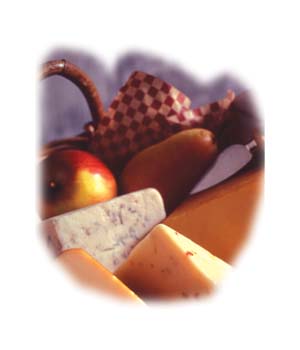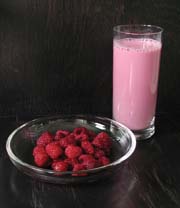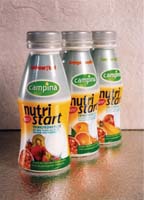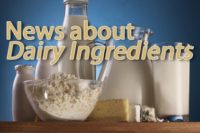
Note: A recent solo trip through my local Dominick's grocery store (somewhat atypical for me these days, as I had no kids with me pointlessly moaning, or more likely, threatening survival if I don't buy something), presented an opportunity to browse the aisles, surveying what's new, and surprisingly, seeing a lot of what's out. Indeed, as I walked up and down the aisles of my supermarket (one very hot and humid Saturday afternoon), something everyone involved in food product development or marketing should do on, at minimum, a quarterly basis, I observed the introduction of some really innovative products; however, I also found many, and I mean many, products with shelf tags identifying them as discontinued. They were discounted for quick sale at about 50% to 75% off. I am now stocked up on several of these items, particularly if I had coupons for them.
You are asking, what's my point? The point is, products come, and products go. Some become timeless treasures, while others have a life span shorter than the expiration date stated on the coupon FSI distributed when the product rolled out.
Product developers and marketers must learn how to make consumer food trends work for them. I don't have the answers, in fact, nobody does, as consumers are fickle, and even a product that scores well in consumer testing frequently fails for one reason or another. However, tried and true, one of the best research tools for product development ventures is information. And we do live in the information age, so there is no excuse. During trips to the grocery store--not just down the dairy aisle, but every aisle--there are things to learn from observing new products (i.e., formulation approaches, label claims, market positionings, etc.). Other good research tools include Internet surfing, magazine reading--trade and consumer--and of course, attending trade shows to learn the latest and greatest. (You will be at Worldwide Food Expo at the end of October, right?) Hopefully this Product Development Trends feature article provides some inspiration, and some ideas. Consider it free market research from yours truly, with some thanks to my little ones for the quiet times I spend in grocery stores.

This doesn't mean we have more time on our hands and are spending hours in the kitchen baking bread from scratch and basting a turkey. The contrary, in fact, is what's true. We have less time. So what's happening? We are relying more heavily on convenience foods, many of which are available in bulk at the many club/warehouse stores that are proliferating around the country. (Have you tried those ready-cooked refrigerated roasts that are ready within five minutes in the microwave? Even better, they have a shelflife of about a month.) That must be why, according to The NPD Group, Port Washington, N.Y., two thirds of households now have a second freezer or refrigerator!
Indeed, convenience continues to be the major driving force influencing consumers' everyday purchases. If it's not something to assist with dinner preparation, it's something for on-the-go consumption--sometimes as a snack, other times as a meal replacement.
This trend is apparent both here and abroad. Take for example Dutch dairy products manufacturer Campina, which markets an on-the-go cultured breakfast beverage in Europe appropriately named NutriStart. The drink, which is 79% low-fat yogurt, comes in convenient single-serve bottles in three flavors: Strawberry-Kiwi, Banana-Apple and Orange-Grapefruit. NutriStart is intended for consumers who, because of their busy lifestyles, do not have enough time for breakfast, yet still want a healthful and tasty way to start their day.
Dairy-based meal replacement beverages are likely to become even more attractive in the United States thanks to FDA's acceptance of low-acid aseptic filling and packaging in plastic bottles. For example, Columbus, Ohio-based Abbott Laboratories recently "kicked the can" by putting its shelf-stable Ensure[r] beverages in 8-oz recloseable plastic bottles, a first in the U.S. adult nutritional category. The drinks come in six-packs, in five flavors: Vanilla, Chocolate, Butter Pecan, Strawberry and Coffee Latte.
Cheese to lower cholesterol
Next to convenience, health and wellness are driving a great deal of product development. Take for example, cheese, which is generally one of the first foods a person gives up when they discover their cholesterol is high. Two cheese marketers, one here and one abroad, are changing this "rule." Not only are they making it possible for consumers with high cholesterol to keep cheese in their diet, they are actually formulating these cheese products in such a way that they have become an important part of the cholesterol-lowering diet.Heartily Wholesome is a product that has been shown to actually lower blood cholesterol levels. Developed and patented by U.K.-based Angel Technology, with technical assistance from Nigel Slater, professor, Cambridge University, Heartily Wholesome is made similar to traditional natural cheese. However, before conventional coagulation occurs, all of the milkfat is removed and replaced by wheat germ oil, which is high in phytosterols and polyunsaturated fats, both of which have been shown to reduce cholesterol. In addition, not only does the cheese contain cholesterol-lowering ingredients, it is itself free of cholesterol, a marked contrast to standard cheese.
Heartily Wholesome tastes and smells like standard mild Cheddar cheese. Initial consumer trials indicate that when an average person ate 65g of Heartily Wholesome daily, they were able to reduce their blood cholesterol by 10% to 13%. In another study, consumers who ate this cheese alternative were able to reduce cholesterol by as much as 20% in three weeks.
Unlike cholesterol-lowering margarines in the marketplace, it is much easier to consume the required amount of Heartily Wholesome to reap the cholesterol-lowering benefit than it is to eat the necessary amount of margarine.
The secret ingredient--phytosterol--helps lower blood cholesterol because it is structurally similar to cholesterol, and consequently, competes with cholesterol for absorption through the small intestine. In essence, the more phytosterols present in the gastrointestinal tract following a meal, the less likely cholesterol absorption will occur. Interestingly, phytosterols themselves are not absorbed to any appreciable extent. They simply block cholesterol absorption and get flushed through the intestines.
Phytosterols are naturally found in fruits, vegetables, whole grains and vegetable oils, but most individuals with high cholesterol do not eat enough of these foods to reap the benefits of phytosterols.
The National Cholesterol Education Program Expert Panel on Detection, Evaluation and Treatment of High Cholesterol in Adults recently updated its clinical guidelines for cholesterol testing and management. One of the recommendations was to use phytosterols as a therapeutic dietary option to lower cholesterol. Furthermore, FDA allows for the health claim: Foods containing at least 0.65g per serving of phytosterols, eaten twice a day with meals for a daily total intake of at least 1.3g, as part of a diet low in saturated fat and cholesterol, may reduce the risk of heart disease.
Armed with this information, Lifeline Food Co., Seaside, Calif., has reformulated its Lifetime[r] Low Fat Cheese to include phytosterol esters. A 1-oz serving of the cheese, which comes in Cheddar, extra sharp Cheddar, jalapeEo Jack and mozzarella, contains 0.65g phytosterols. A serving at two meals provides the recommended amount to reap the cholesterol-lowering benefits.
Parents want more for their kids
Just as adults want convenient and healthful products formulated for their needs, parents expect more out of the products for their children.Londonderry, N.H.-based Stonyfield Farm, innovators of YoBaby[r] organic whole milk yogurts, now offer YoBaby Drinkable Yogurt, the only organic whole milk drinkable yogurt developed specifically to meet the nutritional needs of infants and toddlers. Like all Stonyfield Farm products, YoBaby Drinkable Yogurt contains six live active cultures--more than any other brand of yogurt.
Each culture provides its own unique health benefits, and all six help to enhance digestion as well as boost the immune system. Stonyfield Farm is the only U.S. yogurt to contain Lactobacillus reuteri, a probiotic that inhibits the growth of harmful bacteria. It has also been shown to treat and prevent both viral and bacterial diarrhea, the leading cause of hospitalization for children under the age of three in the United States.
YoBaby Drinkable Yogurt comes in two flavors--Peach and Banana--and contains all the benefits of original YoBaby cup yogurt in a convenient drinkable form. It is packaged in resealable 24-ounce bottles, making it easier for parents to control the portion size that they give to their children.
"We designed YoBaby for the nutritional needs of infants and toddlers," says Gary Hirshberg, pres. and CEO. "Now we are providing both variety and convenience in the form of a drinkable whole milk yogurt--so that it is easier for parents to feed their children organic foods. We all know that babies like to play with their food--being able to pour YoBaby Drinkable Yogurt into a sippy cup ensures that more yogurt ends up in their bellies, and less in their hair."
When Stonyfield Farm launched YoBaby organic whole milk yogurt in 2000 they immediately knew they had a success story. Since its introduction, it has grown at an annual rate of more than 30% and is the most successful product that Stonyfield Farm has ever introduced.
Alan Greene, pediatrician, Clinical Faculty at Stanford University School of Medicine, Stanford, Calif., and Founder and CEO of DrGreene.com, recommends whole milk products for young children beginning around one year of age. "For kids who enjoy dairy products, I recommend those made from whole milk for the first two or three years of life," Greene says. "Fat is such an important component for the growing brain and nervous system. A healthy brain is about 60% fat. By feeding their children whole milk products, parents can help to ensure that their children are receiving many of the fats necessary for proper brain development."
Stonyfield Farm recently got some competition in the whole milk baby and toddler yogurt category. Horizon Organic Holding Corp., Boulder, Colo., now offers Horizon Organic Whole Milk Baby Yogurt, which is for children one- to three-years old. The yogurt comes in two multi-pack flavor combinations: Peach and Vanilla, and Pear and Vanilla.
Since toddlers do not stay small forever, the company also rolled out Yo-Yos yogurt cups for children up to eight-years old. Produced with 1% low-fat milk, Yo-Yos come in two flavors: Soaring Strawberry and Screaming Orange-Cream. And for on-the-go snacking times there are Yogurt Tubes, which are available in 1.5% low-fat Strawberry, Orange-Cream and Blueberry flavors.
"With the addition of these new yogurts to our line of kid-focused products, Horizon Organic has extended the reach of its yogurt brand to include all members of the family," says Gwen Scherer, dir. of marketing for Horizon Organic.
The cultured dairy category is not the only dairy segment with new products just for kids. In fact, more appropriate than cultured dairy is fluid milk, when it comes to fortification, as the beverage segment is the fastest-growing market within the fortified foods market.
New Borden[r] Plus Kid Builder[tm] milks are 1% low-fat milk fortified with protein, calcium and vitamins C and E. Compared to regular 1% low-fat milk, an 8-oz serving of Kid Builder milk contains an additional 2g protein, as well as an additional 10% of the Daily Value (DV) for calcium, 25% for vitamin C and 21% for vitamin E.
These nutrient levels were boosted because of the important roles they play in growing children. Calcium, the most well known, is for bone growth, while protein is for developing body tissues. Vitamin C helps with growth and repair of tissue and is enhanced by vitamin E, which is an antioxidant that assists in the development of healthy body tissues and healthy skin, hair and muscles.
Kid Builder milk comes in three flavors: Chocolate, Vanilla and White. A Kid Builder ice cream is in the works. It will also be low in fat and fortified with value-added nutrients.
More Hispanics in every age group
Within every age segment of the population, there is a growing sub-segment that cannot be ignored--Hispanics. In fact, by the year 2020, it is predicted that consumers with some Hispanic descent will comprise 17% of the population, and will be the largest ethnic minority in the United States.According to the 2002 Food Marketing Institute Report entitled U.S. Hispanics: Insight into Grocery Shopping Preferences and Attitudes, Hispanics spend an average of $117 a week on groceries, whereas all U.S. grocery shoppers spend only about $87. Hispanics also visit the supermarket more frequently than any other consumer segment.
With that said, Hispanic moms and children will have a greater influence on America's food preferences, and the foods being introduced into the marketplace. This is very important to the dairy industry, as Hispanics are large consumers of all dairy products.
This past year, quite a few frozen dessert marketers rolled out products targeting Hispanics, but of course hoping the general population finds them appealing too. For example, Good Humor-Breyers Ice Cream, Green Bay, Wis., introduced Breyers[r] All Natural Fresa Platano, a creamy banana-flavored ice cream with a strawberry swirl. In the novelty category, the company rolled out Popsicle[r] Carnaval de Frutas, water ices in three flavors: coconut, lemon-lime and strawberry. Both products use bilingual packaging.
On the fluid side, there has been a great deal of excitement surrounding the licuado (pronounced lee-kwa-doh), a fresh fruit and milk-based Latin drink. This authentic blended beverage is found throughout Mexico, Central and Latin America. It is traditionally made with cold milk and fresh fruit, like mangoes, papaya, guava, manzana (apple), platano (plantain) and even cacao (cocoa powder). Also sometimes called batidos (pronounced bah-tee-dohs), licuados are enjoyed at sidewalk stalls/booths, known as bars, which colorfully display a wide range of fresh fruit and other ingredients.
Are you picking up on the similarities to smoothie bars? Is there an opportunity for a packaged, single-serve licuado, something like a Hispanic smoothie? Or what about a licuado mix for foodservice, again similar to smoothie mixes?
At the recent Western Foodservice & Hospitality Expo in Los Angeles, the California Milk Processor Board (CMPB), which initiated the licuados effort in the United States, generated a great deal of interest from attendees. CMPB is hoping that foodservice operators will recognize the unique qualities and market viability of this tasty beverage.
One show attendee, a California restaurant owner, made this prediction: "Licuados will become the next burrito. We've seen the number of requests for licuados soar recently as people learn how great they are."
Timed to coincide with the show, CMPB released a guide to the best licuados in the state as a way to share this long-standing Hispanic tradition with non-Latinos. The directory--A Guide to California's Best Licuados--features 105 licuado bars, cafes, restaurants and family-run grocery stores from 56 California cities. The guide is available on-line at www.gotmilk.com.
"As customers look beyond smoothies, foodservice operators are beginning to see that licuados are an easy way to boost beverage sales," says Jeff Manning, executive dir., CMPB. "They're delicious, nutritious and adaptable to any restaurant size and customer base."
A year ago, CMPB held an in-home licuado research study with more than 500 non-Latino Californians (between the ages of 25 and 45) in eight cities across the state.
"Our objective was to determine if licuados could cross-over into mainstream cuisine," says Manning. "Based on these results, licuados could indeed become the next burrito or sangria."
Research highlights include more than 90% of respondents liked the concept of licuados, with 93% liking the taste. Nearly half (52%) thought licuados made a good meal replacement, while 74% thought it would be a great snack.

The high-protein trend
The last noteworthy trend in 2003 has been the endless proliferation of foods and beverages that cater to high-protein, low-carbohydrate diet enthusiasts. This new wave of products supports efforts by the late Dr. Robert Atkins, whose get-thin-quick regimen became famous in the 1970s when he told dieters that fatty foods weren't causing weight gain. Carbohydrates were the culprits. The belief is that if the body is deprived of carbohydrates as a source of energy, it will burn fat.It is estimated that 25 million dieters have tried to follow his diet, and more are hopping on the bandwagon everyday. Recognizing this opportunity, SouthWest Foods, Tyler, Texas, a division of Brookshire Grocery Co., has become the leader among dairy manufacturers and marketers participating in this trend.
For example, the company recently rolled out LeCarb Dairy Drink, a reduced-lactose milk alternative and the first low carbohydrate drink of its kind. LeCarb Dairy Drink uses membrane technologies to remove most of the lactose from regular whole milk. Wholesome ingredients like milk proteins and calcium are then added back to fortify the product before it is slightly sweetened with sucralose.
"Millions of Americans are either diabetic or watch their carbohydrate intake through many popular low-carb diets," says Fred Calvert, senior v.p. "LeCarb products are an effort to give this growing group everyday items they have been unable to consume before."
LeCarb Dairy Drink not only meets the needs of diabetics and low-carb dieters, but that of parents trying to moderate their children's sugar intake by providing a wholesome snack with 67% less sugar, 25% to 50% more protein and 35% more calcium than regular whole milk.
The drink is available in 64-oz cartons in three varieties: LeCarb Dairy Drink and LeCarb Low Fat Dairy Drink, which have 4-4.5g of carbohydrates compared to 12g in regular whole milk, and LeCarb Chocolate Dairy Drink, which contains only 6g of carbohydrates compared to 28-32g in regular chocolate whole milk. Lactose has been reduced 70% in the LeCarb Dairy Drink and LeCarb Low Fat Dairy Drink, with LeCarb Chocolate Dairy Drink offering an 80% reduction.
Also in the LeCarb line is LeCarb Frozen Dessert, which was introduced in 2001, as well as recently introduced YoCarb, a low-carb cultured dairy blend. With 80% less sugar than regular low-fat yogurt and a maximum of 4g of carbohydrates per serving, YoCarb is a practical replacement for yogurt fans and a healthy addition to low-carb and diabetic diets.
Like the other LeCarb products, YoCarb is sweetened with sucralose. YoCarb contains half the calories of regular low-fat yogurt, and has the lowest combination of carbs, fat and calories of any yogurt-like cultured dairy blend.
YoCarb comes in 4-oz cups in seven flavors: plain, strawberry, key lime, strawberry banana, lemon, peach mango and blueberry.
Since the beginning of the year, high-protein, low-carbohydrate foods have been rolling out at a rate of almost three new products a day, according to Productscan, a marketing-intelligence firm in Naples, N.Y. There's an opportunity here for dairy manufacturers to assist America with the obesity crisis.
In summary, remember product trends come and go. Very few become classics. However, to reap the benefits of a trend, manufacturers must be timely in their introductions, as well as be effective marketers. Product developers and marketers must learn how to make consumer food trends work for them. I hope this overview provided some inspiration.
Workshop Presents Opportunities in Health Claims
Looking to help dairy products manufacturers and marketers capitalize on the new flexibility in federal rules on food health claims, the International Dairy Foods Association (IDFA) will hold a special training opportunity entitled "A Healthy Pitch: Compelling Health Claims for Your Dairy Products" on October 28, 2003, in Chicago. The workshop is being held in conjunction with Worldwide Food Expo (WWFE) 2003; workshop attendees will receive a complimentary registration to WWFE."This workshop is about striking while the iron's hot," says Ellen Brophy, IDFA senior director of educational services and business development. "FDA will accept qualified food health claim petitions this fall under its new rules, so it's an ideal time for manufacturers to learn how to leverage the health benefits of consuming dairy products."
During this one-day workshop, industry experts--including IDFA Vice President of Regulatory Affairs Cary Frye--will explain how other food and beverage manufacturers are already taking advantage of health claims to market their products. Attendees will also learn about how consumers feel about health claims, and what catches their attention in the competitive marketplace. Instructors will guide dairy manufacturers through the regulatory requirements from both FDA and the Federal Trade Commission about how dairy's benefits can be communicated on packaging, in advertising and through public relations efforts. In addition, attendees will learn about emerging scientific research surrounding specific opportunities for dairy, including potential claims on hypertension and weight loss.
At WWFE, dairy foods product developers will be able to learn about the latest and greatest in food science and ingredients, in order to formulate foods that effectively compete in today's health- and wellness-driven marketplace. WWFE runs October 29 to November 1 at Chicago's McCormick Place. For complete information, visit www.worldwidefood.com.
Registration rates for IDFA's "A Healthy Pitch: Compelling Health Claims for Dairy" are $495 for members and $695 for non-members. For a complete workshop agenda and registration information, visit the "Meetings and Training" section of www.idfa.org, or call 202/220-3557.
Food Still is Fun and Indulgent
Cold Stone Creamery, Scottsdale, Ariz., the ice cream franchise chain famous for made-to-order ice cream flavor combinations, where the inclusions are folded into ice cream on a granite stone, claims its new Cake Batter[tm] ice cream is the next Cookie Dough. The new flavor incorporates the rich and confectionary taste of homemade cake batter straight from the bowl with the smooth and creamy texture of Cold Stone Creamery's superpremium ice cream."We are introducing an unprecedented ice cream flavor with an amazing new taste to ice cream lovers around the world," says Lisa Levi, Cold Stone Creamery media relations specialist. "It's a milestone for Cold Stone Creamery, but even more importantly it's a major milestone in the industry and is sure to make ice cream history."
Although new Cake Batter ice cream can stand on its own, the possibilities to personalize and customize the flavor are endless. Cold Stone Creamery has started the creative process of blending the new flavor of ice cream with name brand mix-ins. For example, Candyland[tm] is Cake Batter ice cream mixed with a M&M's[r], Snickers[r] and KitKat[r] candy pieces. Cherry Cake Double Take[tm] is Cake Batter ice cream mixed with delicious, delectable black cherries, diced toasted almonds, pure golden sweet honey and soft sponge cake.



